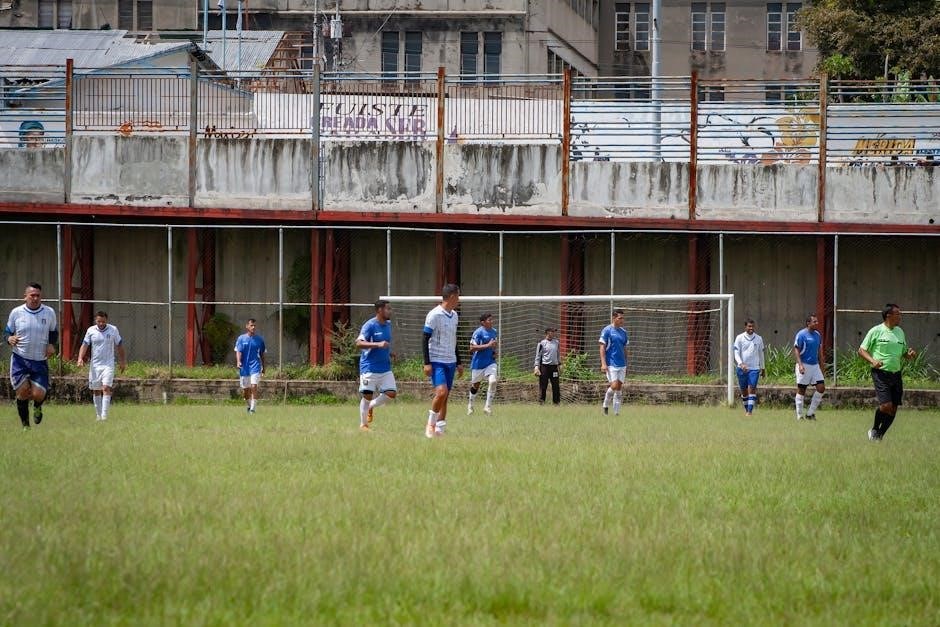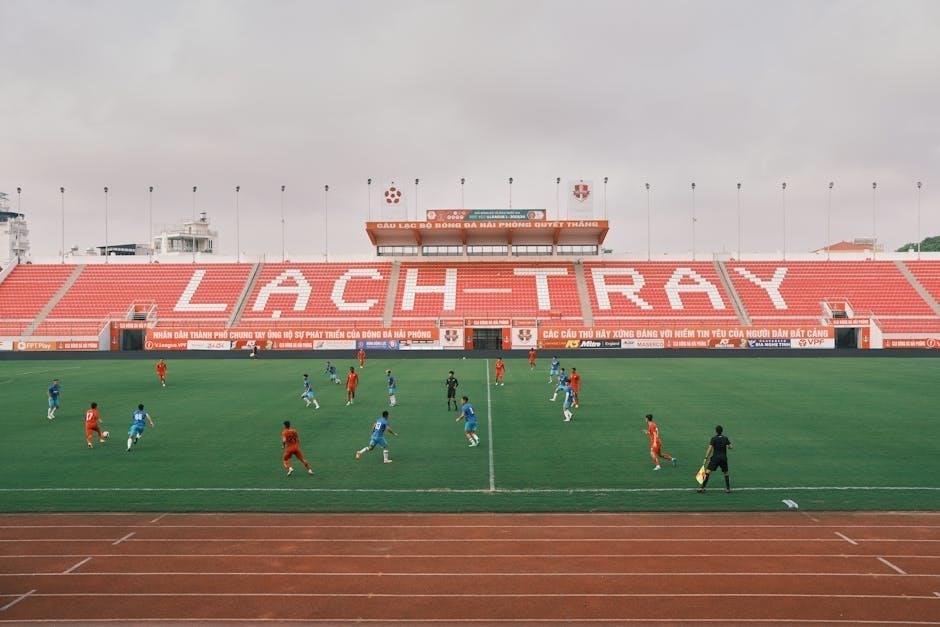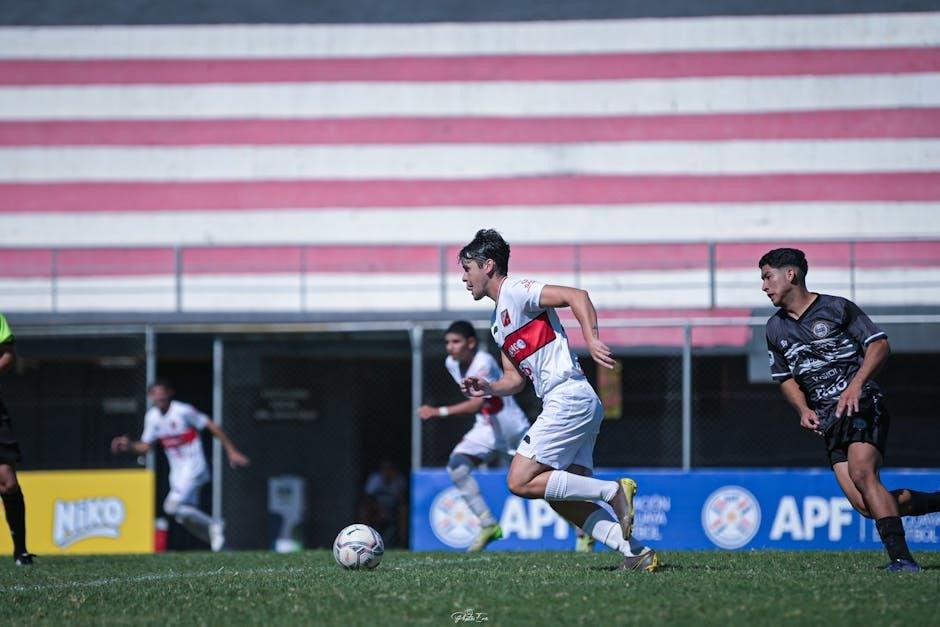football referee signals pdf
Football referee signals are essential for maintaining order and clarity in matches. Official PDF guides provide detailed diagrams and explanations of each signal‚ ensuring consistency across all levels of play.
Importance of Referee Signals in Football
Referee signals are crucial for maintaining order‚ fairness‚ and clarity in football matches. They ensure consistent communication between officials‚ players‚ and spectators. Clear hand signals help referees enforce rules effectively‚ reducing confusion and disputes. Proper signaling fosters a structured game flow‚ allowing players to understand decisions instantly. Accurate signals also uphold the integrity of the game‚ ensuring fair play and adherence to regulations. Official PDF guides detail these signals‚ providing a standardized reference for referees worldwide. Their importance cannot be overstated in delivering a smooth and professional match experience.

Overview of Common Signals and Their Purposes
Football referee signals are standardized gestures used to communicate decisions clearly during matches. Common signals include indicating scoring plays‚ such as touchdowns or field goals‚ and managing game flow‚ like starting or stopping the clock. Other signals address penalties‚ such as holding‚ offsides‚ or unnecessary roughness. These visual cues ensure consistency and clarity for players‚ coaches‚ and spectators. They also help maintain order and fairness‚ allowing referees to enforce rules effectively. By standardizing these signals‚ referees provide instant understanding‚ enhancing the overall efficiency of the game.
Evolution of Referee Signals in Football
Referee signals have evolved from basic gestures to standardized systems‚ ensuring clarity and consistency. Governing bodies like the NFL and NCAA have formalized signals over time‚ adapting to rule changes and technological advancements.
Historical Development of Hand Signals
Football referee hand signals have a rich history‚ evolving from simple gestures to standardized communication tools. Early referees relied on whistles and basic arm movements to manage games. Over time‚ signals became more precise‚ with the introduction of flags and specific hand positions to denote penalties like offsides or holding. By the early 20th century‚ governing bodies began formalizing these signals‚ ensuring consistency across leagues. This standardization laid the groundwork for modern referee communication‚ enhancing clarity and fairness in the sport.
Modern Updates and Standardization

Modern football referee signals have undergone significant updates to ensure clarity and consistency. Governing bodies like the NFHS and NCAA regularly revise signal guidelines‚ incorporating feedback from referees and players. Standardization ensures universal understanding‚ with signals like the “ball ready for play” and “touchdown” being universally recognized. Official PDF guides and training materials are widely distributed‚ detailing each signal’s purpose and proper execution. These updates enhance communication‚ reducing confusion and ensuring fair play across all levels of competition.

Basic Referee Signals
Basic referee signals include essential gestures for managing gameplay‚ such as “ball ready for play” and “start clock.” These signals ensure clear communication and smooth game flow.
Start of Play and Time Management Signals
Referees use specific signals to indicate the start of play and manage time effectively. The “ball ready for play” signal alerts teams the game is resuming‚ while the “start clock” gesture begins the play clock. Discretionary or injury time-outs are signaled by raising the arm and tapping the chest. These clear gestures ensure both teams and officials are synchronized‚ maintaining the game’s flow and adherence to timing rules. Proper execution of these signals is crucial for fair and efficient gameplay management.

Scoring and Dead Ball Signals
Scoring and dead ball signals are crucial for clearly indicating game outcomes. A touchdown is signaled with arms extended sideways‚ while a field goal uses a raised arm and index finger. Points after a touchdown are shown by moving the side-to-side arm. A safety is indicated with both palms facing down. Dead ball signals‚ like incomplete pass (arms spread wide) or loss of down (hand rotating)‚ halt play. These signals ensure clarity and fairness‚ keeping players‚ coaches‚ and fans informed of the game’s progress and scoring situations.
Penalty Signals
Penalty signals clearly indicate fouls‚ ensuring fair play. Common signals include extending an arm for holding or chopping hands for offsides. Officials use these gestures to enforce rules effectively. Referee signals are detailed in official PDF guides for accurate interpretation.

Common Penalty Signals and Their Meanings
Common penalty signals include extending one arm for holding or chopping hands for offsides. A raised fist indicates pass interference‚ while a sweeping motion signals unnecessary roughness. Officials use these gestures to communicate fouls clearly. For example‚ tapping the shoulder or chest may denote illegal use of hands. Each signal has a specific meaning‚ ensuring consistency in enforcement. Official PDF guides detail these signals‚ helping referees‚ players‚ and fans understand the rules effectively during matches.
Signalting Unnecessary Roughness and Other Fouls

Signaling Unnecessary Roughness and Other Fouls
Referees signal unnecessary roughness by driving one fist into the other palm. This gesture emphasizes contact beyond normal play. Other fouls‚ like face mask or spearing‚ are indicated with specific hand motions. For example‚ a grasping motion at face level signifies a face mask penalty. These signals ensure clarity and consistency in enforcing rules. Official PDF guides outline each gesture‚ helping officials communicate effectively and maintain fair play throughout the game.

Communication Signals
Referees use hand signals and whistles to communicate effectively. Clear gestures indicate timeouts‚ fouls‚ and play resumption. Official PDF guides detail these essential signals for consistent enforcement.
Referee-Player Communication
Effective communication between referees and players is crucial for game clarity. Referees use hand signals and verbal cues to convey decisions. Key signals include timeout gestures‚ first down indicators‚ and touchdown confirmations. Clear whistle commands and visible gestures ensure players understand rulings. Official PDF guides outline standardized signals‚ promoting consistency. Referees must maintain eye contact and use precise movements to avoid confusion. This system ensures smooth gameplay and fair enforcement of rules‚ fostering respect and understanding between officials and athletes.
Signals for Team Timeouts and Substitutions
Referees use distinct signals to manage timeouts and substitutions. For timeouts‚ officials tap their chest with both hands or hold a “T” shape. Substitutions are signaled by placing one hand on the head or using a specific gesture. These signals ensure clarity and maintain game flow. Official PDF guides detail these signals‚ helping referees and teams understand the rules. Proper communication prevents confusion‚ ensuring smooth transitions during play stoppages.
Key Situations and Their Signals
Key situations‚ like goals and touchdowns‚ are signaled with raised arms or pointing towards the end zone. Officials ensure clarity in critical moments‚ guiding players and spectators.
Goal‚ Touchdown‚ and Field Goal Signals
Referees signal scoring plays with distinct gestures. A touchdown is indicated by raising both arms vertically‚ while field goals are signaled with a raised arm and index finger. For goals‚ officials may point to the posts or use a sweeping motion. These signals ensure clarity for players‚ coaches‚ and spectators. Consistency in execution is crucial to avoid confusion during pivotal moments in the game. Official PDF guides detail these signals‚ ensuring uniformity across all levels of play.
Signals for Incomplete Passes and Inadvertent Whistles
Referees signal an incomplete pass by raising both arms straight above their head‚ indicating the ball was not caught. For inadvertent whistles‚ officials use a slashing motion across the neck to signal the stoppage and restart of play. These signals are critical for maintaining game flow and ensuring accurate officiating. Official PDF guides emphasize proper technique to avoid confusion among players and spectators. Consistency in executing these gestures is vital for fair and clear communication during the match.

Resources for Learning Referee Signals

Official PDF guides and training materials provide detailed diagrams and explanations of referee signals. Video tutorials and visual aids are also available‚ offering step-by-step instructions for mastering signals.
Official PDF Guides and Training Materials
Official PDF guides are comprehensive resources detailing football referee signals. These documents‚ published by governing bodies like the NFHS‚ include diagrams‚ explanations‚ and rules. They cover basic signals‚ penalties‚ and special situations‚ ensuring clarity for referees. Training materials often accompany these guides‚ offering practical exercises and quizzes. Referees can download these resources from official websites‚ making them accessible for self-study or classroom training. Regular updates ensure referees stay informed about rule changes and signal modifications‚ maintaining consistency across all levels of play.
Video Tutorials and Visual Aids
Video tutorials and visual aids are invaluable for mastering football referee signals. Platforms like YouTube and official federation websites offer step-by-step guides‚ demonstrating signals in real-time. These resources complement PDF guides by providing visual clarity‚ making complex signals easier to understand. Many tutorials include practical exercises and real-game examples‚ allowing referees to practice and refine their techniques. Visual aids‚ such as diagrams and animations‚ further enhance learning‚ ensuring consistency in signal application. These tools are accessible to referees of all levels‚ fostering improved performance and rule enforcement.
Understanding football referee signals is crucial for fair play. Official PDF guides and video tutorials provide comprehensive resources‚ ensuring referees master these essential gestures for effective game management.
Key football referee signals ensure clarity and fairness in gameplay. Signals like touchdown‚ incomplete pass‚ and holding are vital for communicating decisions instantly. Consistent hand gestures and flag usage maintain game flow and player understanding. Accurate signaling prevents disputes and ensures rules are upheld. Official PDF guides and training materials detail each signal‚ helping referees master their execution. Proper signaling fosters trust in referees’ decisions‚ enhancing the integrity of the game for players‚ coaches‚ and fans alike.
Future of Referee Signal Development
The future of referee signals lies in innovation and technology. Video assistant referees (VAR) and wearable technology are enhancing accuracy and consistency. Standardized hand signals remain crucial‚ but digital tools now support referees in real-time. Official PDF guides are being updated to include modern techniques and interpretations. As the game evolves‚ so too will the signals‚ ensuring clarity and fairness. Training materials are adapting to integrate these advancements‚ preparing referees for the next generation of football officiating.
